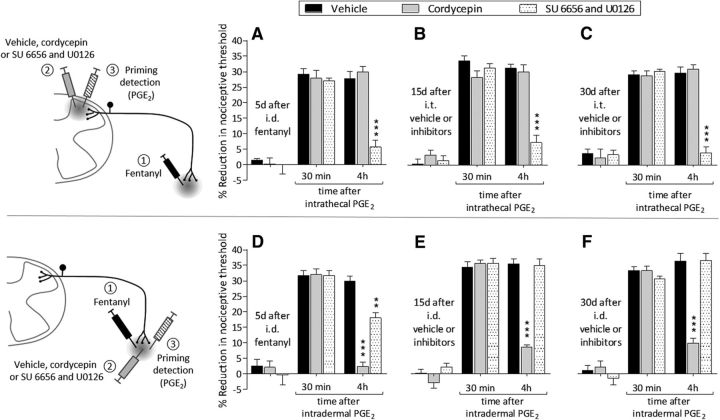Figure 5.
Intradermal fentanyl induces type II priming at the central and type I priming at the peripheral terminal. A, Rats received an intradermal injection of fentanyl (100 ng/5 μl). Five days later, vehicle (10 μl, black bars), cordycepin (4 μg/10 μl; gray bars), or the combination (dotted bars) of SU 6656 (10 μg/5 μl) and U0126 (10 μg/5 μl) was injected intrathecally followed by an intrathecal injection of PGE2 (400 ng/10 μl). Thirty minutes after injection, PGE2 induced mechanical hyperalgesia in all groups. However, in the group treated with the combination of SU 6656 and U0126, PGE2-induced hyperalgesia at the fourth hour was inhibited (F(2,30) = 156.03, ***p < 0.0001, when SU 6655 and U0126 group is compared with the vehicle-treated group at the fourth hour after the injection of PGE2; two-way repeated-measures ANOVA followed by Bonferroni post hoc test), whereas in the vehicle- and cordycepin-treated groups, PGE2 induced prolonged hyperalgesia. B, Fifteen days after treatment with vehicle, cordycepin, or the combination of SU 6656 and U0126, when the mechanical nociceptive threshold was not different from the pre-vehicle/inhibitors baseline (t(5) = 0.4416; p = 0.6772, for the vehicle-treated group, t(5) = 0.2162; p = 0.8374, for the cordycepin-treated group, and t(5) = 0.8402; p = 0.4391, for the combination of SU 6656 and U0126-treated group, when the mechanical nociceptive threshold is compared before and after treatments; paired Student's t test), PGE2 (400 ng/20 μl) was again injected intrathecally. Two-way repeated-measures ANOVA, followed by Bonferroni post hoc test, showed a significant inhibition of the prolonged hyperalgesia induced by PGE2 at the fourth hour, in the group that had been pretreated with the combination of SU 6656 and U0126, compared with the vehicle-treated group (F(2,30) = 257.50, ***p < 0.0001, when the hyperalgesia in the vehicle-treated and the combination of SU 6656 and U0126-treated groups is compared at the fourth hour), whereas PGE2 induced prolonged hyperalgesia in the cordycepin-treated group. C, When PGE2 was injected again, 30 d after treatment with vehicle or the inhibitors, in the group previously treated with the combination of SU 6656 and U0126, PGE2-induced hyperalgesia was not present at the fourth hour (F(2,30) = 200.87, ***p < 0.0001, when the hyperalgesia in the vehicle- and the combination of SU 6656 and U0126-treated groups is compared at the fourth hour after intrathecal PGE2; two-way repeated-measures ANOVA followed by Bonferroni post hoc test), demonstrating that intradermal fentanyl produces type II priming in the central terminal (n = 6 paws/6 rats per group). D, Rats received an intradermal injection of fentanyl (100 ng/5 μl). Five days later, vehicle (5 μl, black bars), cordycepin (1 μg/5 μl; gray bars) or the combination (dotted bars) of SU 6656 (1 μg/2 μl) and U0126 (1 μg/2 μl) was injected intradermally followed 10 min later by an injection of PGE2 (100 ng/5 μl) at the same site on the dorsum of the hindpaw. Mechanical nociceptive threshold was evaluated 30 min and 4 h after intradermal PGE2. Mechanical hyperalgesia was observed in all groups 30 min after the injection of PGE2. However, treatment with cordycepin prevented the prolongation of PGE2-induced hyperalgesia (F(2,30) = 207.62, ***p < 0.0001, when the hyperalgesia in the vehicle- and the cordycepin-treated groups is compared at the fourth hour after intradermal PGE2; two-way repeated-measures ANOVA followed by Bonferroni post hoc test), whereas treatment with the combination of SU 6656 and U0126 only partially attenuated hyperalgesia at the fourth hour after PGE2 (**p < 0.001, when the hyperalgesia in the vehicle- and the combination of SU 6656 and U0126-treated groups is compared at the fourth hour; two-way repeated-measures ANOVA followed by Bonferroni post hoc test). E, Fifteen days after treatment with vehicle, cordycepin, or the combination of SU 6656 and U0126, when the mechanical nociceptive threshold was not different from the prevehicle/inhibitors baseline (t(5) = 1.585; p = 0.1737, for the vehicle-treated group, t(5) = 0.8682; p = 0.4250, for the cordycepin-treated group, and t(5) = 1.097; p = 0.3227, for the combination of SU 6656 and U0126-treated group, when the mechanical nociceptive threshold is compared before and after treatments; paired Student's t test), PGE2 (100 ng/5 μl) was again injected intradermally. Two-way repeated-measures ANOVA, followed by Bonferroni post hoc test, showed that, whereas the hyperalgesia induced by PGE2 in the vehicle and combination of SU 6656 and U0126 groups was still present at the fourth hour, in the group pretreated with cordycepin, it was significantly inhibited (F(2,30) = 245.80, ***p < 0.0001, when the hyperalgesia in the vehicle- and the cordycepin-treated groups is compared at the fourth hour after intradermal PGE2). F, Thirty days after treatment with vehicle, cordycepin, or the combination of SU 6656 and U0126, PGE2 (100 ng) was again injected intradermally. In the group previously treated with cordycepin, the prolongation of PGE2-induced hyperalgesia was markedly attenuated at the fourth hour (F(2,30) = 239.59, ***p < 0.0001, when the hyperalgesia in the vehicle- and the cordycepin-treated groups is compared at the fourth hour after intradermal PGE2; two-way repeated-measures ANOVA followed by Bonferroni post hoc test), whereas in the groups treated with vehicle or the combination of SU 6656 and U0126, the hyperalgesia was present at the fourth hour. These findings support the suggestion that intradermal fentanyl induces type I priming in the peripheral terminal (n = 6 paws/6 rats per group).

